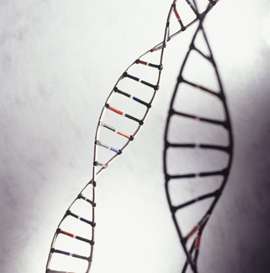January 26, 2016 report
Genomic study of Indian populations finds five distinct ancestral components

(Phys.org)—A trio of researchers with the National Institute of BioMedical Genomics, in India has found via genetic study, five distinct ancestral components for the people of India. In their paper published in Proceedings of the National Academy of Sciences, Analabha Basu, Neeta Sarkar-Roy and Partha Majumder describe their genetic analysis of the genomes of several hundred people from across the country and what their study revealed about Indian history.
Prior research had found evidence that suggested that the vast majority of India's people came from just two ancestral populations. The researchers with this new effort have widened that number to five, four distinct "haplotypes" on the mainland and one among the people of the Andaman archipelago.
To learn more about the ancestral history of present-day Indians, the researchers collected tissue samples from 367 people from 18 locations on the mainland and two from the Nicobar and Andaman Islands (a total of 20 ethnic groups were represented)—the team then conducted a genomic analysis that allowed for comparing the lineage of those among the test group with one another and also with samples of other people held in the Human Genome Diversity Panel.
The team reports that their study revealed that the four ancestral groups they found included what they describe as people of north and south Indian ancestries, people of Austro-Asiatic descent and people with Tibeto-Burman ancestries. Those from the islands were found to share genes with present-day Pacific Islanders. They also found evidence of the first Indians coming from Africa—another later wave of people came to the area from East and South Central Asia. They also found that the earliest people tended to intermingle for many years, sharing their genes across lineages, but that came to halt approximately 70 generations ago, which equated to approximately 1,575 years ago—the time period of the Gupta emperors, when the caste system was begun. Intermingling between the upper and lower castes diminished to the point that it could be seen in the genes of people alive today.
The researchers note that their study has revealed that Indian ancestry is far more genetically diverse than has been thought and also point out that they have shown that shifts in societal practices can lead to changes in the genomes of the people that live there, over many generations.
More information: Analabha Basu et al. Genomic reconstruction of the history of extant populations of India reveals five distinct ancestral components and a complex structure, Proceedings of the National Academy of Sciences (2016). DOI: 10.1073/pnas.1513197113
Abstract
India, occupying the center stage of Paleolithic and Neolithic migrations, has been underrepresented in genome-wide studies of variation. Systematic analysis of genome-wide data, using multiple robust statistical methods, on (i) 367 unrelated individuals drawn from 18 mainland and 2 island (Andaman and Nicobar Islands) populations selected to represent geographic, linguistic, and ethnic diversities, and (ii) individuals from populations represented in the Human Genome Diversity Panel (HGDP), reveal four major ancestries in mainland India. This contrasts with an earlier inference of two ancestries based on limited population sampling. A distinct ancestry of the populations of Andaman archipelago was identified and found to be coancestral to Oceanic populations. Analysis of ancestral haplotype blocks revealed that extant mainland populations (i) admixed widely irrespective of ancestry, although admixtures between populations was not always symmetric, and (ii) this practice was rapidly replaced by endogamy about 70 generations ago, among upper castes and Indo-European speakers predominantly. This estimated time coincides with the historical period of formulation and adoption of sociocultural norms restricting intermarriage in large social strata. A similar replacement observed among tribal populations was temporally less uniform.
Journal information: Proceedings of the National Academy of Sciences
© 2016 Phys.org





















